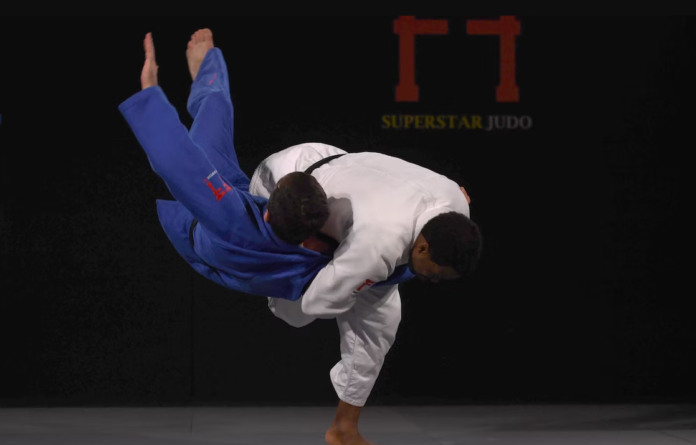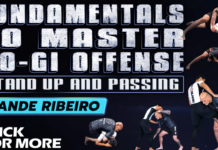
Do you want to learn how to throw your opponent in style? What do BJJ, MMA, and wrestling have in common? They all use hip toss variations to take down their opponents, especially as high-effective follow-ups to failed takedowns and throws.
A hip toss is a versatile set of moves based on the premise of loading an opponent onto one’s hip and then taking them down by a variety of different maneuvers. Hip tosses can improve your balance, timing, leverage, and control, as well as give you an advantage in positioning and scoring.
In this article, you will learn the basic principles, the common variations, and the tips and tricks for executing and finishing hip tosses.
Basic Principles of Hip Tosses
The main principle behind the setup of a hip toss is to make the opponent’s hips go back while they are leaning forwards. This allows you to plant your hips underneath your opponent and pull them into the hip toss while pulling them up and over your body onto the mat.
To do this, you need to break their balance (kuzushi) by pulling, pushing, or feinting with your arms and body.
The footwork of a hip toss involves planting your feet just slightly in front of the opponent’s hips. At first, the footwork takes some practice to get used to because you end up crossing your feet.
Crossing your feet puts you out of position in wrestling so when you plant your feet in the correct position, you need to execute the throw right away. You can also use a back step or a pivot to create more momentum and angle for the throw.
The arm position for a hip toss depends on the type of grip you have on your opponent. Most people use an underhook to do the hip toss, but it’s possible to perform a hip toss with an overhook too.
The other arm typically has wrist control but bicep or inside control works too. You’ll get more leverage with the inside control since you’re grabbing closer to their center of gravity. You can also use different grips such as lapel, collar, or sleeve if you are wearing a Gi.
The key to using your hips as a fulcrum for a hip toss is to make sure they are lower than your opponent’s hips and aligned with their center of gravity. It should feel as if your opponent is falling up and over you.
You can also use a subtle trick of pulling your opponent up from the mat so that they are light on their toes. This makes it much easier to execute the hip toss than if your opponent’s feet are still heavily planted on the ground.
Exploring Common Hip Toss Variations
There are many variations of hip tosses that are used in different martial arts, such as judo, wrestling, and BJJ. They differ from each other in terms of grip, angle, direction, and setups.
Judo Hip Tosses
Judo has 10 official hip tosses (koshi-waza) that are classified according to their direction, grip, and leg action. Some examples are:
- O Goshi: a large hip throw that involves putting one hand behind the opponent’s back and lifting them over your hip. This is often the first throw taught to beginners as it is simple and effective.
- Uki Goshi: a floating hip throw that involves sliding your hip under the opponent’s waist and tilting them over your hip. This is a variation of o goshi that requires less lifting and more timing.
- Harai Goshi: a sweeping hip throw that involves sweeping one leg across the opponent’s legs and throwing them over your hip. This is a powerful throw that can be used when the opponent tries to escape o goshi by jumping forward.
- Hane Goshi: a spring hip throw that involves lifting one leg between the opponent’s legs and throwing them over your hip. This is a dynamic throw that can be used when the opponent tries to resist harai goshi by blocking your leg.
- Utsuri Goshi: a changing hip throw that involves switching your hips with the opponent’s hips and throwing them over your shoulder. This is a counter throw that can be used when the opponent tries to lift you up for their own hip toss.
Hip Toss Wrestling Variations
Wrestling has several variations of hip tosses that are based on different grips, head positions, and entries:
- Headlock toss a move that involves locking your arm around the opponent’s head and throwing them over your hip. This is a simple and effective throw that can be used from various clinch positions.
- Arm Drag Reverse Hip Toss: a move that involves grabbing the opponent’s arm and flipping them over your hip by planting one of your legs in between theirs. This is a quick and sneaky throw that can be used when the opponent reaches for your collar or neck.
- Single Leg to Hip Toss: Olympic gold medalist wrestler Henry Cejudo has a really slick hip toss wrestling variation that is perfect for grapplers of all levels.He sets it up with an inside tie and looks to shoot for a single leg takedown. If the shot fails, the backup option is a very effective hip throw. You then step in just like for a Judo hip throw with an over-under control over his shoulders.
Best Possible Hip Toss Variation for BJJ and Grappling
BJJ has adapted some of the wrestling hip tosses for its No-Gi grappling context, Judo throws for Gi situations, as well as developed some of its own variations based on different scenarios and positions.
How do you choose the best possible variation of hip toss for Brazilian Jiu-Jitsu and grappling? It depends on factors such as your body type, your opponent’s stance, your grip options, your level of skill, and your preferred position after landing.
Here are some general guidelines:
- If you are taller than your opponent, you can use variations that involve lifting them up with your hips, such as o goshi.
- If you are shorter than your opponent, focus on variations that involve sweeping their legs with yours, such as harai goshi or hane goshi.
- If you have strong grips or are wearing a Gi, you can use variations that involve pulling their sleeves or lapels, such as sode tsurikomi goshi or harai goshi.
- If you have weaker grips or are not wearing a Gi, you can use variations that involve underhooks or overhooks, such as the headlock, arm drag, and single leg setups from wrestling.
Conclusion
Hip tosses are powerful and versatile takedowns that can be used in BJJ, MMA, and wrestling. They are based on the principle of using your hips as a fulcrum to throw your opponent over your body. You can execute them from different grips, angles, and directions depending on the situation and your preference. They can also be combined with other techniques such as feints, fakes, shots, or combinations to set them up more effectively.

















































